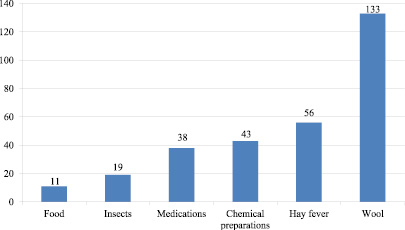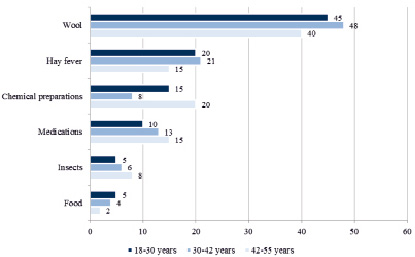Allergic diseases represent the most frequent pathological forms of immunity, caused by an excessive immune response, and that’s one of the relevant issues nowadays. Among the most actively disputed problems, associated with allergic diseases, are: investigating the role of the genetic background in progression of such diseases, evaluating predisposition to diseases of one type, which result in progression of other types of disturbances, as well as the probability that one immunopathology eliminates the development of another.
Not only internal but a lot of external risks factors as well are common in progression of allergic diseases. The immune system can be affected by pathogens of contagious diseases, medicines, various toxic substances, etc. They cause reactions of hypersensitivity to external allergens or disturbances in recognizing its internal antigens. Besides, medicines, chemical substances, food, wool, hay fever, insects and others are also risks factors, which cause disturbances of protective barriers and penetration of allergens into the organism.
Partially, mechanisms of allergies have already been investigated by scientists up to date. It’s agreed to divide them into:
– Hypersensitivity of immediate type (HIT)
– Hypersensitivity of delayed type (HDT)
It’s found out that the HIT very often manifests fast: from several seconds to 12 hours. In most cases the allergic reaction manifests within 30 minutes.
HDT, in turn, manifests only in 24-72 hours.
The allergy is accepted to be divided into T-lymphocyte dependent and B-lymphocyte dependent. Scientists offered five types of allergic reactions in all:
– Reaction of immediate type (It is preconditioned by a contact with IgE antigen)
– Cytotoxic type (the reaction takes place after repeated blood transfusions)
– Arthus type (develops in food allergy)
– Reaction of delayed type
– Receptor mediated type
In allergy immunoglobulins M, G, A, D and E are activated. The main function of an antibody is eliminating alien antigens. IgM is first produced after аntigens’ penetration in the body. IgG is a secondary immune response. IgA is an actively synthesized immunoglobulin in the body. IgD makes the immune defence stronger. And the rise of IgE in the body is characterized by allergic reactions development.
Antibodies, in their turn, divide into 4 types:
– Cellular ones (aggressive)
– Blocking ones (they block allergens)
– Free ones (they are sited in blood)
– Bystanders (they do not take part in reaction)
The aim of the research is to reveal different types of allergic reactions, to which people with weak immunity are often vulnerable using a questionnaire.
As we know, the reaction of immediate type hypersensitivity underlies the majority of allergic diseases. An allergen stimulates Th2-cells differentiation and proliferation of B-lymphocytes, which produce IgE under the influence of cytokines. These antibodies bind with receptors on the surface of mast cells and basophiles, starting a typical effector response and causing an allergy.
Antibodies revealing is closely connected with the concept autoallergy. It’s a pathological process, based on production of IgE-antibodies against the body’s own antigens. The process is triggered by environmental allergens, which have structural or immunological similarity with human proteins. Binding with IgE-autoantibodies on the surface of the mast cells, autoantigens induce a release of inflammation mediators and progression of immediate type hypersensitivity reaction. At this, autoantigens’ presentation by dendritic cells or monocytes mediated by IgE can cause T-cells proliferation, cytokines releasing and progression of delayed-type allergic reaction. The forming antigen-antibody immune complexes could be carried by the bloodstream all over the body and bind with all cells, which have IgE receptors, causing inflammatory processes in various organs.
It’s been lately proven that CD4+CD25+Foxp3+Treg are able to prevent progression of both allergic and autoimmune diseases. Treg control the immune response, suppressing the activity of such immune-competent cells as: CD4+ and CD8+ T-cells, B-cells, natural killers, antigen-representative cells and mononuclears, and it controls antibodies production as well. Their function is provided by means of suppressive cytokines secreted, inactivation of proinflammatory IL-2, cytolisis, reduction of costimulation and submission of antigens.
TIM are highly conservative proteins, which are expressed on the cells of the immune system. They are represented by 3 types: TIM-1, -3, -4. Interaction of those types causes progression of Th2 immune process with a generation of a humoral immunity reaction. TIM-3 represented in those who have a food allergy, and it is located on intestinal epithelial cells. TIM-4 inhibits progression of allergic reactions [1].
During cytotoxic hypersensitivity responses IgG and IgM interact with antigens on the cell’s surface. Its manifestations can be contact cytolisis, predominantly implemented by cytotoxic T-lymphocytes, natural killer cells. Another mechanism is represented as antigen-antibody complexes, which form on the membranes, involve the complement system and trigger lysis of target cells.
Formation of immune complexes occurs in hypersensitivity reactions of immunocomplex type (Arthus phenomenon). They form because of interaction of external and internal antigens with IgG- or IgA-antibodies, which gather in tissues, causing their inflammation. Circulatory immune complex (CIC), which circulates in bloodstream freely, forms in interaction of IgG with antigen. And then it binds with other components and gets phagocytosed [2]. Arthus reaction develops in repeated antigen introduction, which forms an immune complex in the place of its penetration. It manifests by edema, inflammation and necrosis.
The fourth type of immunopathological reactions (hypersensitivity of delayed-type) is conditioned by macrophages and Th1-lymphocytes, which are responsible for cellular immunity stimulation. HDT is caused by CD4+T-lymphocytes and CD8+T-lymphocytes, which secrete cytokines, which activate macrophages, and induce inflammation. In some disturbances CD8+CTL(cytotoxic T-lymphocytes) kill directly the target cells, which carry MHCI+allergen complexes.
The receptor-mediated type is conditioned by producing antibodies to cells’ receptors. When they bind together with receptors, they block or imitate the mediator/hormone working [3].
Some attention should be paid to the factors, which have a positive influence on an allergic reaction to start. It’s not a secret that contacting with the environment is very good for a human body. But in conditions of a mild climate a park with a big number of poplars, maples, birches, oaks, lawns, covered with various kinds of flowers, become a potential enemy to allergic people [4]. In recent years scientists observe an increasing tendency of respiratory allergies to pollen [5].
South-East Asia authors incline to the opinion that the environment has an active influence on children younger than 6 years old. Environmental pollution cause asthma, eczema and rhinoconjunctivitis [6].
Very often an allergic reaction is caused by the food we eat. For instance, a daily food ration of every third citizen of our planet includes sweets. The common reason to like it is its taste. That’s why chocolates are so popular and widespread, but they cause allergic reactions as well[7]. But not only confectionary is harmful to our bodies. Common food allergens are citrus fruits, mostly oranges [8].
Children are vulnerable most frequently to these processes. The American scientists found out that children younger than 6 years old suffer from allergic reaction to cow milk, and, first of all, that one has a negative influence on the immune system development [9].
Cashew allergy more often becomes a big issue not only for children but for adults as well: it’s life-threatening because of anaphylaxis. Anaphylactic shock is a dangerous form of allergy; it’s very dangerous for a human being. The European scientists, struggling against the allergic reaction to cashew-nuts, decided to mark the food, containing this product [10].
Reactions to allergens, in a way, are different: in addition to rash, anaphylactic shock, it manifests as urticaria, allergic dermatitis, lung obstruction syndrome and Quincke’s disease, which affects 95 % of people. The disease is a reaction to an allergen, it swells up areas of skin and changes the person’s appearance[11]. Nettle-rash (or urticaria) makes human body cells die, old age comes faster, strong weakness develops which in most cases results in death[12]. As a consequence of food allergy, the following symptoms can be seen: vomiting, cramps, food refusal, stomach pain, headache. The common causes of it are: side effects of medicines, contagious diseases, IBS[13].
It’s very important to investigate the factors and mechanisms of allergy and to prevent it, because it will promote changing the immunity development, decreasing the risks of infections and chronic immune diseases as well as preventing death outcome[14].
Methodology and results of the research
We performed an inquiry using Google forms to investigate the most common causes of allergy. The investigation was performed in 2018. Respondents, who suffer from allergy, were offered to pass an interview (a rating-poll). It included the list of allergens, symptoms and a short explanation of allergy causes (table).
The interview was performed with people of different ages, mostly aged 18-55. The given choice of respondents was not random, because there were people of different ages, who suffer from various allergies. In total there were 300 respondents. After analyzing the interview, we could make up the following statistics (Fig. 1):
Types of allergic reactions
|
Allergen |
Symptoms |
Causes of allergy |
|
1. Food |
Pain, nausea, stomach disturbance, skin rash, breathing problems |
Food (citrus fruits, nuts, milk etc.) |
|
2. Wool |
Nasal stuffiness, tearing, coughing |
Develops after contact with an animal (or just wool) |
|
3. Chemicals |
Eczema, itching and skin redness |
Using powder, chlorine, soaps for the dishes |
|
4. Hay fever |
Nasal stuffiness, eye itching, edema and redness of eyelids |
Develops because of dust or pollen at home |
|
5. Medicines |
Rash, skin redness |
Caused by aspirin or penicillin |
|
6. Insects |
Itching skin, red swollen spots, tearing eyes |
Bites of ants, wasps , bees, mosquitoes |

Fig. 1. Most common types of allergies in Russia

Fig. 2. Most common types of allergies in people of different ages
The minority of food allergy percentage and wool (or allergy to home animals) allergy predominance are observed. And, to get the whole picture of it, we offer a diagram with their proper percentage (Fig. 2).
Respondents aged 18 to 30 mostly suffered from pet wool (45 %), 20 % of them suffered from hay fever, 15 % had allergic reactions to chemicals, 10 % were allergic to medicals and only 5 % of them complained of food allergy and allergic bites of insects. The answers showed that young people reacted mostly to two natural indicators: wool and hay fever (poplar wool, fluff, bloom).
The allergic group of people aged 30-42 showed the next results: 4 % of them suffered from food allergy; 6 % of the group had an allergy to insects’ bites; 13 % suffered from medicals; 8 % suffered from chemicals; 21 % were vulnerable to hay fever; the predominant majority suffered from pet wool, it’s number is 48 %.
The allergic people aged 42 to 55 were vulnerable to wool (40 %); 15 % of people – to hay fever; 20 % – to chemicals; 15 % – to medicines; 8 % – to insect bites and only 2 % were allergic to food. In comparison with the group of young people, the respondents of this category were more vulnerable to chemical and medical conditions, but not to natural ones. And here also we see the predominant role of the pet wool allergen.
Conclusion
We analyzed the answers obtained through the above-mentioned interviewing test. And thus, we can conclude the following: people of different ages are equally vulnerable to numerous types of allergic reactions. That’s why it’s one of the main issues of healthcare to fight (and we hope, to win) the disease, talking to it in its language, perhaps not easy to get sometimes, and using the weapon, which kills it. It’s so much important nowadays to understand the mechanisms of allergy, to distinguish its types and how exactly we should struggle with it, not only eliminating its symptoms temporarily, but getting rid of it so as the patient could enjoy the rest of his life without any allergy. The need to fight allergies will put an end to immune system weakening and fatal outcome.

